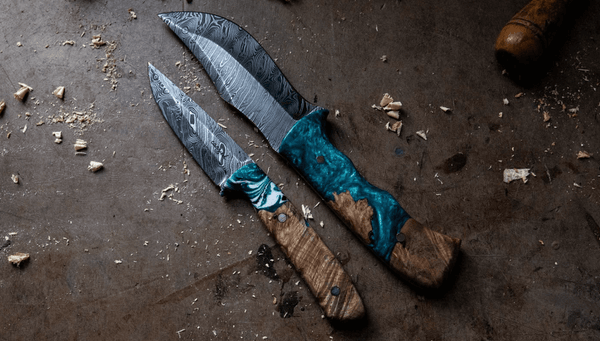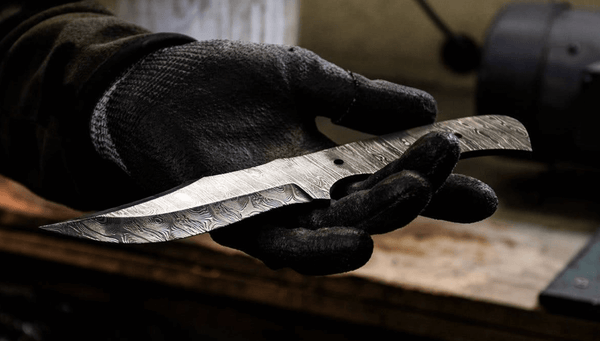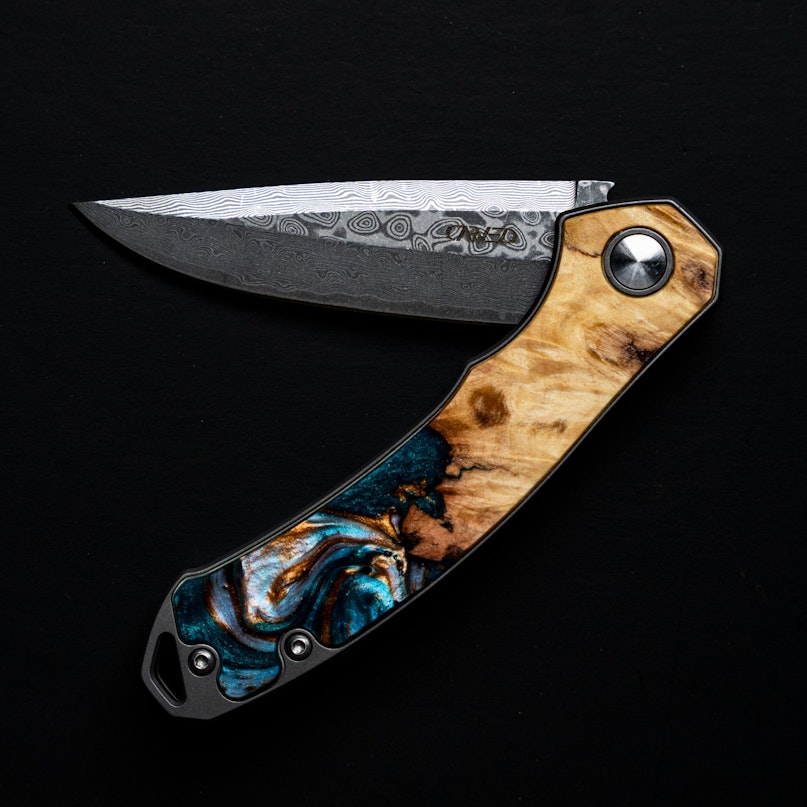
Knives are an essential tool in every kitchen, everyday carry (EDC) loadout, and toolkit, and for good reason. With a history of reliability, precision, and multi-functionality, knives are one of the greatest tools of all time. But with so many types of knives that vary by blade shape, handle material, and use case, it’s become far more than just an everyday tool.
We’re going to explore the most popular types of knives, both folding and fixed blade, and break down the significance of each, along with their benefits and appropriate usage. Whether it’s an EDC folding pocket knife or a chef’s knife to impress your houseguests, you’ll know exactly which type of knife suits you best.
So, whether you're an EDC enthusiast, chef looking to expand your culinary arsenal, or a hunter looking for your next blade, you’re bound to learn something new about these tools. And perhaps, you’ll even add a new one to your collection.
6 Types of Folding Knives
Folding knives contain a blade that can be folded into the handle, making them compact and easy to carry in your pocket. These knives are popular among outdoor enthusiasts, everyday carry enthusiasts, and those who value portability, especially for frequent flyers. Let's explore the most popular types of folding knives:
1. Pocket Knife
The pocket knife is a versatile tool that fits comfortably in your pocket. It typically features multiple blades, including a primary blade for general use, as well as additional tools like screwdrivers, scissors, can openers, and bottle openers. Pocket knives come in a variety of sizes and designs, catering to different needs and preferences, like everyday carry (EDC) enthusiasts and other hobbyists.
2. Utility Knife
The utility knife is a smaller, multipurpose knife that bridges the gap between a paring knife and a chef's knife. It’s perfect for tasks that require more precision than a chef's knife can offer, such as trimming small fruits and vegetables or slicing sandwiches and small cuts of meat.
3. Multi-tool Knife
Multi-tool knives are an all-in-one solution for various tasks. They combine a small folding knife with a range of additional tools, such as pliers, screwdrivers, saws, and scissors. These knives are ideal for camping, hiking, and other outdoor activities, especially if you need to pack a few tools but lack the storage space. Another bonus of multi-tools is that you can carry them with you on planes, as long as they don’t have a sharp blade.
4. Tactical Knife
Tactical knives are designed to be durable, strong, and versatile. They feature a folding blade with a serrated edge, along with additional features like a glass breaker or a seatbelt cutter. Tactical knives are popular among military personnel, law enforcement officers, and survivalists.
5. Swiss Army Knife
The Swiss Army Knife is an iconic multi-tool folding knife that originated in Switzerland. It gained worldwide recognition for its versatility, reliability, and quality craftsmanship. A typical Swiss Army Knife contains blades, screwdrivers, scissors, saws, can openers, and more. It’s a must-have tool for outdoor enthusiasts and EDC specialists.
6. Hunting Knife
Hunting knives are specifically designed for hunting and outdoor activities. They typically feature a folding blade with a sharp point and a curved cutting edge, making them ideal for skinning, field dressing, and processing game. Though all hunting blades functionally serve the same purpose, there are some that are better than others, like Damascus steel hunting knives, or others that feature gut hooks and bone saws for specific use cases.

6 Types of Fixed Blade Knives
Fixed blade knives are known for their durability and strength, making them an excellent choice for heavy-duty tasks. And unlike folding knives, they cannot be folded away in your pocket. They must be stored safely in a case, sheath, or another safe location. Let's explore some of the most popular types of fixed blade knives:
7. Chef's Knife
The chef's knife, also known as a cook's knife or French knife, is the prized possession of any self-respecting chef. With a broad blade and curved edge, it’s the go-to tool for slicing, dicing, and chopping fruits, vegetables, and herbs. Compared to a steak knife, the blade is longer & taller, but shorter than a carving knife. However, despite its heavy-duty look, steak & carving knives are more effective at cutting meats.
8. Santoku Knife
Originating from Japan, the Santoku knife has gained immense popularity for its versatility and precision. This knife features a shorter, wider blade with a straighter edge, making it ideal for precise slicing, dicing, and mincing. The Santoku knife is particularly well-suited for cutting vegetables, fish, and boneless meats. The Japanese food culture is a proud one, and the Santoku reflects that. Compared to chef’s knives, Santokus are thinner and made from a tougher steel, resulting in thinner, higher-quality cuts.
9. Paring Knife
The paring knife is a small, versatile knife with a narrow blade and a pointed tip. It’s primarily used for intricate tasks that require precision, such as peeling, trimming, and shaping fruits and vegetables. The compact size of the paring knife allows for better control and maneuverability.
10. Boning Knife
As the name suggests, boning knives are designed for deboning meat, poultry, and fish. The thin, flexible blade easily glides along bones and joints, separating the meat with precision. The narrow, pointed tip allows you to cut through even the tightest space, minimizing waste and maximizing yield.
11. Filet Knife
Filet knives are specifically designed for fileting and skinning fish. These knives have a thin, flexible blade that glides along the contours of the fish, removing only the skin and bones so as to preserve the delicate meat. And because fish scales are so tough, these blades tend to be more flexible than other types, allowing you to wrestle with the cut without breaking the blade or damaging the meat.
12. Cleaver
Cleavers are heavy-duty knives with a thick, rectangular blade. Traditionally used for chopping through bones and tough cuts of meat, cleavers are also versatile enough to handle other tasks such as smashing garlic and transferring chopped ingredients from the cutting board to the pan. They provide excellent leverage and power due to their weight and sturdy construction. If you’ve watched any of the outdoor cooking videos on TikTok or Instagram Reels, these faceless creators almost always use cleavers – it’s a rugged-looking blade.
13. Bread Knife
The bread knife is a staple of restaurants & kitchen tables everywhere. Characterized by a long, serrated blade, bread knives slice through loaves of sourdough & ciabatta without crushing or tearing. The serrated edge allows for a sawing motion, cutting through the crust while maintaining the soft interior of the bread. This knife also works for slicing delicate cakes and pastries.
Each of these types of knives has their own distinct shape, flexibility, and application, which is what makes each so special. Just as you wouldn’t use a bread knife to filet a fish, you wouldn’t cut your steak with a pocket knife. And with a variety of different handles and blade shapes for each of these knives, there are countless variations on even the simplest knife styles.
In the vast realm of knives, the diversity and specificity of blade shapes are truly astounding. From the earliest days of sharpened stones to the modern marvels of metallurgy, the evolution of knife blades has been a testament to human ingenuity and adaptability. Each blade shape, with its unique design and purpose, tells a story of the tasks it was meant to conquer and the hands it was designed to fit. Whether you're a chef, a hunter, an adventurer, or simply someone who appreciates the art of craftsmanship, there's a blade shape tailored to your needs. As you venture into the world of knives, remember that the right blade can make all the difference, enhancing precision, safety, and efficiency. So, arm yourself with knowledge, choose wisely, and let your blade be an extension of your intent.



